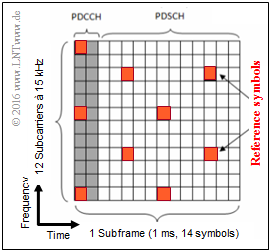Exercise 4.4Z: Physical Channels in LTE
The task refers to the two pages
All information required for the task can be found on these pages.
The diagram shows the assignment of the two channels PDCCH and PDSCH in frequency and time:
- One frequency block comprises $180 \ \rm kHz$ and is divided into twelve $15 \ \rm kHz$–subcarriers
- A subframe is one millisecond long and includes $14$ symbols.
- Red marked are so called reference symbols.
Notes:
- The task belongs to the chapter Bitübertragungsschicht bei LTE.
Questionnaire
Sample solution
(1) Correct are the solutions 3 and 4:
The assignment to Downlink or Uplink can be recognized by the second letter. It means:
- PDCCH: Physical Downlink Control Channel,
- PDSCH: Physical Downlink Shared Channel,
- PUCCH: Physical Uplink Control Channel,
- PUSCH: Physical Uplink Shared Channel.
(2) Correct are the solutions 2 and 4:
- Ein „C” ⇒ Control als dritter Buchstabe weist auf einen Kontrollkanal hin.
- Nutzdaten werden stets in den Shared Channels ⇒ „S” übertragen,
(3) Alle Aussagen sind zutreffend:
- Ein Block im LTE–Downlink belegt im Frequenzbereich $180 \ \rm kHz$ (zwölf Unterträger zu je $15 \ \rm kHz$) und hat die Dauer $1 \ \rm ms$.
- Die Belegung mit PDCCH und PDSCH zeigt, dass der Downlink betrachtet wird.
- Die Referenzsymbole werden benötigt, um die Kanalqualität zu schätzen und den Channel Quality Indicator (CQI) zu berechnen.
- Diese Referenzsymbole sind auf unterschiedliche Frequenzen bzw. Symbole (verschiedene Zeiten) verteilt, um die Kanalqualität möglichst umfassend schätzen zu können.
(4) Die Aussage 1 stimmt, da hier nur zwei der $14$ Spalten vom Kontrollkanal PDCCH belegt werden.
Verallgemeinern kann man dieses Ergebnis allerdings nicht. Vielmehr ist die Aufteilung zwischen PDCCH– und PDSCH–Symbolen abhängig von den Anforderungen des Nutzers und damit dynamisch.
- Bei vielen Nutzern mit niedriger Datenrate würde der PDCCH drei oder vier Symbole umfassen, weil hier eine intensivere Abstimmung nötig ist als bei wenigen gleichzeitigen Nutzern mit jeweils hoher Datenrate.
- Dem Endgerät wird die Information „Wie viele PDCCH–Symbole” über den Physical Control Format Indicator Channel (PCFICH) mitgeteilt.
(5) All statementsabove are correct:
- Die Datenrate eines jeden Nutzers hängt direkt von der Anzahl der ihm zugewiesenen Blöcke der Breite $180 \ \rm kHz$ ab.
- Die LTI–Gesamtfrequenzbreite liegt zwischen $1.4 \ \rm MHz$ und $20 \ \rm MHz$.
- In das Frequenzband von $1.4 \ \rm MHz$ werden sechs Blöcke à $180 \ \rm kHz$ untergebracht.
- Der Overhead beträgt somit $(1.4 - 6 \cdot 0.18)/1.4 \approx 22.8 \%$.
- Bei $20 \ \rm MHz$ Gesamtfrequenzbreite, also $100$ Blöcken, ist der Overhead $(20 - 100 \cdot 0.18)/26 = 10 \ \%$.
- Je mehr Blöcke insgesamt zur Verfügung stehen, desto mehr kann jedem einzelnen Nutzer zugewiesen werden, wenn sein Kanal gut ist und wenn nicht gleichzeitig viele andere Nutzer ebenfalls große Ansprüche stellen.
